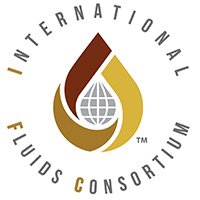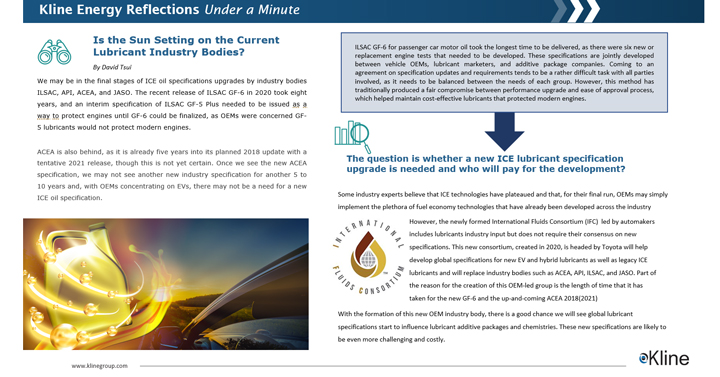Kline Energy Reflections Under a Minute
We may be in the final stages of ICE oil specifications upgrades by industry bodies ILSAC, API, ACEA, and JASO. The recent release of ILSAC GF-6 in 2020 took eight years, and an interim specification of ILSAC GF-5 Plus was needed to be issued to protect engines until GF-6 could be finalized. This was needed as OEMs were concerned that GF-5 lubricants would not protect modern engines.
ACEA was already five years past its planned 2018 update with it’s 2021 release. Now that the new ACEA specification has been released, we may not see another new industry specification for another 5 to 10 years and, with OEMs concentrating on EVs, there may not be a need for a new ICE oil specification.
ILSAC GF-6 for passenger car motor oil took the longest time to be delivered, as there were six new or replacement engine tests that needed to be developed. These specifications are jointly developed between vehicle OEMs, lubricant marketers, and additive package companies. Coming to an agreement on specification updates and requirements tends to be a rather difficult task with all parties involved, as it needs to be balanced between the needs of each group. However, this method has traditionally produced a fair compromise between performance upgrade and ease of approval process, which has helped maintain cost–effective lubricants that protected modern engines.
The question is whether a new ICE lubricant specification upgrade is needed and who will pay for the development?
Then there is the question of whether we will need a new ICE lubricant specification upgrade and who will pay for the development, as OEMs are largely focused on EVs, and the global recession from COVID-19 has caused OEMs and lubricant companies to tighten their financial belts. Some industry experts believe that ICE technologies may have plateaued and that, for their final run, OEMs may simply implement the plethora of fuel economy technologies that have already been developed across the industry, as there is no major reason to invest in developing any new technology for an engine that is vilified by global governments. When one sums the time, expertise, and cost of developing new engine tests to substantiate a new specification, it all seems less likely that we will see a new specification upgrade.
 However, the International Fluids Consortium (IFC) is a newly formed industry body led by automakers that includes lubricants industry input but does not require their consensus on new specifications. This new consortium, created in 2020, is headed by Toyota and will help develop global specifications for new EV and hybrid lubricants as well as legacy ICE lubricants and will replace industry bodies such as ACEA, API, ILSAC, and JASO. Part of the reason for the creation of this new OEM–led group is the length of time that it has taken for the new GF-6 and the recently released ACEA 2018(2021) specifications, which this new consortium seeks to address by removing the requirement for lubricant marketers and lubricant additive companies to reach a consensus with the OEMs on development of new specifications.
However, the International Fluids Consortium (IFC) is a newly formed industry body led by automakers that includes lubricants industry input but does not require their consensus on new specifications. This new consortium, created in 2020, is headed by Toyota and will help develop global specifications for new EV and hybrid lubricants as well as legacy ICE lubricants and will replace industry bodies such as ACEA, API, ILSAC, and JASO. Part of the reason for the creation of this new OEM–led group is the length of time that it has taken for the new GF-6 and the recently released ACEA 2018(2021) specifications, which this new consortium seeks to address by removing the requirement for lubricant marketers and lubricant additive companies to reach a consensus with the OEMs on development of new specifications.
With the formation of this new OEM industry body, there is a good chance we will see global lubricant specifications start to influence lubricant additive packages and chemistries. These new specifications are likely to be even more challenging and costly.
To gain deeper insight into the lubricant additives industry, subscribe to Kline’s study, Global Lubricant Additives: Market Analysis and Opportunities.
Get the quick infographic overview here.
OR REQUEST RECORDING OF OUR LIVE WEBINAR: Global Lubricant Additives: What Does the Future Hold?
During this webinar we discussed:
– Size, trends, and demand of the global lubricant additives market
– Insights into supply chain and finished lubricants market
– Impact of regulatory changes and COVID-19 on global trade and the lubricant additives market
– Impact of specification upgrades


